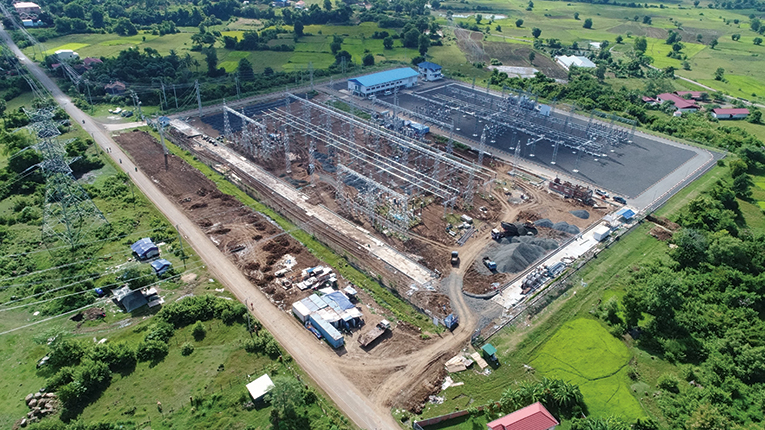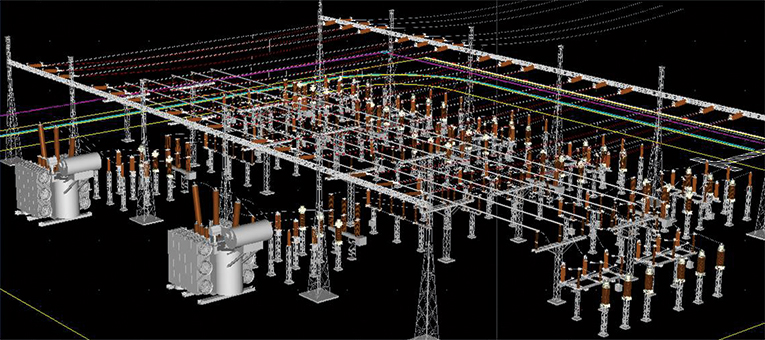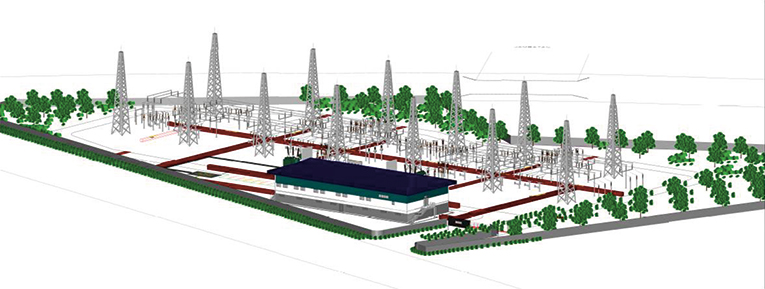PESTECH's Build, Operate, Transfer Project for Cambodia Substation and Transmission System Bolsters Regions Electricity
Introduction
Bentley System’s Year in Infrastructure Conference 2017 wrapped up with its Be Inspired Awards. The Be Inspired Awards recognize the greatest BIM advancements in infrastructure in 17 categories. In the BIM Advancements in Utilities Transmission and Distribution category, PESTECH International Berhad won for its work on the 230-kilovolt substation and transmission system from the town of Kratié to the city of Kampong Cham, Cambodia.
Following is the case study for this award-winning project. Solutions from Bentley played a significant role in enabling PESTECH to complete this challenging project while saving time and money.
Substations and Transmission Line to Bring the Power
A new network in Cambodia was designed to meet the power needs of an area that is experiencing development and urbanization. Diamond Power Limited awarded a contract to PESTECH International Berhad to design, supply, deliver, erect, and commission the 230-kilovolt Kratie and Kampong Cham Substation and Transmission System in Cambodia. An obje tive of the custom-designed high voltage (HV) and extra high voltage (EHV) system is to prolong the life and reliability of the transmission and distribution assets.
Kratie, a province located in northeastern Cambodia and Kampong Cham, is the third-largest city in the country, situated about 57 miles away from Kratie. Both areas are not tourist destinations, but backpackers pass through Kampong Cham during the high season seeking accommodations as it is a transit point between Siem Reap and Phnom Penh, both of which are popular tourist spots.
The new Kratie 230/22-kilovolt substation will serve as a major collection center of electricity power from additional mini-hydropower plants and will be connected to the national power grid of Cambodia. The 125-kilometer 230-kilovolt duplex ACSR bittern transmission line will connect the new Kratie Substation to an updated Kampong Cham Substation. This line will transfer 700 megawatts of electrical power from Sesan Hydropower Plant, which is nearing completion in the upper Mekong area, to the Kratie and Kampong Cham regions. Power from the plant will also be transmitted through the Kampong Cham-Kratie transmission line to Cambodia’s capital, Phnom Penh.
Comprehensive Engineering Design by PESTECH
Established in 1991, PESTECH International Berhad is an electrical trading company in Malaysia that specializes in creating electrical power facilities in developing countries and has a market capitalization of over MYR 1 billion. The company has evolved from delivering power transmission infrastructure to building and operating transmission assets, embedding system software and product development, and most recently power generation and rail electrification.

PESTECH was contracted to do the transmission portion of the project and the primary and secondary design of the substation system for the $92.2 million dollar project. PESTECH created a conceptual design of the substation systems and assembled, installed, tested, and commissioned the 230-kilovolt switchyard within the existing Kampong Cham Substation, a new Kratie 230/22-kilovolt substation, and the interconnecting 230-kilovolt duplex ACSR bittern transmission line that connects the Kampong Cham Substation to the Kratie Substation. The primary design included designing the substation layout and the secondary design included the control and relay panel protection panels.
Advancing Past Manual Methods
Previously, the engineering team designed and manually updated 2D hand-made drawings, conducted manual component calculation, and used AutoCAD. This methodology was inconsistent, time consuming, labor intensive, and prone to human error. Additionally, the manual method created a divide between the electrical and physical design. Drawings and design deliverables were dispersed among all stakeholders, so information sharing was disorganized and inefficient, often impacting construction when outdated files were referenced, necessitating expensive and time-consuming rework. PESTECH’s previous schematic diagram also did not incorporate intelligent functions, such as clash detections, lightning protection design simulation, and automated functions for drawings and report generation.
Visualization of the 3D substation design was essential for preparing work before and during construction, and the software implemented was integral for collaboration across departments, both on and off site.
Integrating 2D Electrical and 3D Physical Designs
Using a robust platform of software solutions for the 3D physical design and 2D electrical design, PESTECH’s engineering team created a systematic database and catalog. It took the team about one month to put together a full set of libraries that consisted of hundreds of parts. After the database was fully comprehensive, the design drawings used a pick and drop method for the electrical design of the 3D substation layout and the 2D electrical schematics of the control relay and protection panels. This saved the team time on submissions and revisions.
The combined platform of 3D substation design with 2D electrical protection, along with control schematics and panel design, provided the engineering team with a seamless review of the project, eliminating the need for multiple applications. The unified environment also lim¬ited manual coordination needed to keep the electrical and physical designs constant and it promoted greater collaboration across the multi-discipline team. The unified design environment eliminated data re-entry, reduced manual coordination, enabled cross-discipline collaboration, curtailed drawing errors, avoided rework, enhanced efficiencies in design work, and created an interconnected design.
The software for the primary and secondary design phases of the project optimized workflows and the team of electrical and civil engineers designed and constructed the project to meet all standards, electrical parameters, and safety requirements. The engineering team developed libraries, databases, and templates compliant with Cambodian standards.
Visual Simulation During Primary Design Stage
During the primary design, the substation system needed to be laid out, including transformers, gantry towers, large cables, and circuit breakers. It was essential that these designs adhere to regulatory standards and be created via accurate engineering calculations. The team produced visual simulations of lightning protection of the area, grounding grid design functions, and took advantage of navigational functionalities with components interlinked in the parts database.
Also, hook point technology enabled 3D components to snap automatically, saving significant time.
Additionally, an intelligent substation digital engineering model helped the team automate their design drawings and reports. The automatic diagram and report generation, real-time post-process error checking, smart PDF generation, and simple navigation of the intelligent 2D and 3D models saved the team
The software used significantly reduced time for the project team through automatic diagram and report generation, real-time post-process error checking, smart PDF generation, and simple navigation of the intelligent 2D and 3D models.
Plug-ins were developed with the API generated information automatically, saving time. The Automatic Wire Numbering plug-in automatically named thousands of wires within a minute and panel wiring numbers were generated instantly. Over 100 kinds of panels were used in the substation that required thousands of schematics pages, because each panel has over 50 components. With the Graphical Report Plugin, all the schematics pages were generated automatically within a few seconds after the schematic design was complete. Other reports, such as bills of materials, cable schedules, tables of contents, and terminal connection diagrams were all automatically produced with the report templates prepared.
Saving Time and Money
PESTECH has estimated that the project took 70 percent less time than other projects of this scale. Schematic drawings were completed in fewer than seven days, when they would normally take between two to three weeks with prior methods. 3D design with the software took three days, whereas similar 3D design in CAD took two weeks and required each design to be drawn and viewed separately. Additionally, the application automatically generated cable schedules within one hour for the en¬tire project when it would typically take three days to check and document each cable. A further example of the time-savings with the software is evident in how a plug-in allowed terminal function diagrams to be generated in just seconds rather than three days it would have taken to manually document and check the report.
Using the software solutions, the PESTECH engineering team achieved accurate generated drawings and documentation, saved time on drawing production, saved money in procurement, and delivered better visualized substation presentations with 3D primary and 2D secondary engineering design unified in a single application.
With More Power Comes a Greater Impact
With Cambodia growing as a tourist destination and Kampong Cham having roads that connect to major Cambodian cities, added electricity to this region of the country through the substation is vital for future development. Concurrent with the construction of the substation is the construction of additional highways between Kampong Cham and the capital city of Phnom Penh. These routes will benefit the tourism industry as well as the surrounding community as it allows for better transit access for cars and buses. Further electricity in the area is also set to spur construction of hotels and resorts.
The two substations are expected to be completed by the end of 2017. After the 24-month project is complete, the Kratie and Kampong Cham area will have enhanced electricity usage that supports the quick development of the region and PESTECH will operate and maintain the power transmission system for a 25-year period.


Project Summary
Organization
PESTECH International Berhad
Solution
Utilities Transmission and Distribution
Location
Kratie and Kampong Cham, Cambodia
Project Objectives
- To design and construct a new Kratie substation, update the switchyard in the Kampong Cham substation, and erect a 125-kilometer 230-kilovolt duplex ACSR bittern transmission line that connects both.
- To increase electrical power generation to this region of Cambodia in order to further development of buildings and highways to cater to increased tourism in nearby cities.
Fast Facts
- PESTECH was contracted to design, supply, deliver, erect and commission the 230-kilovolt Kratie and Kampong Cham substation and transmission system in Cambodia.
- 3D visualization helped PESTECH overcome site and transportation challenges
- PESTECH was awarded a 25-year contract to operate and maintain the power transmission system.
ROI
- Schematic drawings were completed in less than a week rather than two to three weeks with previous methods.
- Automatic generation with the technology created cable schedules for the entire project in one hour and terminal function diagrams in seconds, rather than three days if done manually.
- 3D design that previously required two weeks was conducted in three days.
- The software used helped streamline engineering design with on overall 70 percent in time savings.
 Cyndi Smith is a senior industry marketing director for Bentley Systems’ utilities, water, and communications industries. In her 16 years at Bentley, Smith has also led Bentley’s product marketing team and the global utilities solutions strategy as solution executive. She has an extensive background in the development, implementation, and marketing of solutions for infrastructure in the communications, defense, oil and gas, and utilities industries.
Cyndi Smith is a senior industry marketing director for Bentley Systems’ utilities, water, and communications industries. In her 16 years at Bentley, Smith has also led Bentley’s product marketing team and the global utilities solutions strategy as solution executive. She has an extensive background in the development, implementation, and marketing of solutions for infrastructure in the communications, defense, oil and gas, and utilities industries.







